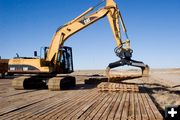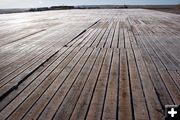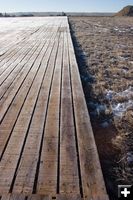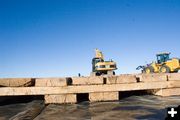

Mats for ground protection
Wooden oak 'mats' are placed on top of native sage brush to test their effectiveness in reducing impacts of heavy equipment at EnCana's natural gas well drill sites. Photo courtesy EnCana USA.
|


Oak plank mats
Oak plank mats are placed on top of the ground at well sites.
|
|
EnCana uses mats to protect wildlife habitat
by EnCana USA
December 6, 2005
(Pinedale) EnCana Oil & Gas (USA) Inc. is initiating a voluntary surface reclamation pilot project in the Jonah Field that is designed to protect wildlife habitat by decreasing disturbance by as much as 60% and hastening revegetation of disturbed ground at natural well drilling sites.
Instead of blading off sage brush and scraping roads and well pads, EnCana’s project involves laying down two to three acres of wooden oak mats on top of the native sage brush vegetation. Heavy equipment and machinery then cross on top of the wooden planks, which causes less damage to surface vegetation.
Using the wooden mats on well sites protects the plant root system of native vegetation that would otherwise be damaged by well site activity. As mats are laid down, they flatten the plants, but topsoil and root systems is largely undamaged. The first mat location is being tested in the Jonah Field and a drilling rig erected on the mats.
"EnCana’s goals are to test and improve practices that give alternatives to directional drilling and also decrease impacts to natural resources, wildlife and air quality," said Jeff Johnson, EnCana Jonah production team leader, in an EnCana news release. "If the mat technique is successful in Jonah, we may use it in other oil and gas fields in Wyoming and other western states to help reduce impacts."
Keeping the root system intact is expected to speed up the revegetation and recovery process of the site to its normal condition, thereby promoting habitat for sage grouse and pronghorn antelope.
"Compared to standard construction and drilling, using the mats will decrease initial surface disturbance by as much as 60 percent," said Johnson.
The mat technique is only a part of a study EnCana is doing to research and monitor drilling practices in the Jonah Field. The two purposes of the study are to test possible ways to decrease the immediate and long-term impacts from drilling and completion activities, and to study the effects of combined low-impact drilling, completion and production operations.
According to Steven Hall, BLM external affairs chief, when it comes to rehabilitating the sagebrush-dominant ecosystem in Jonah, making sure the existing seed banks stay intact is a big challenge; one the BLM hopes this project will help.
Photos courtesy EnCana USA
|



